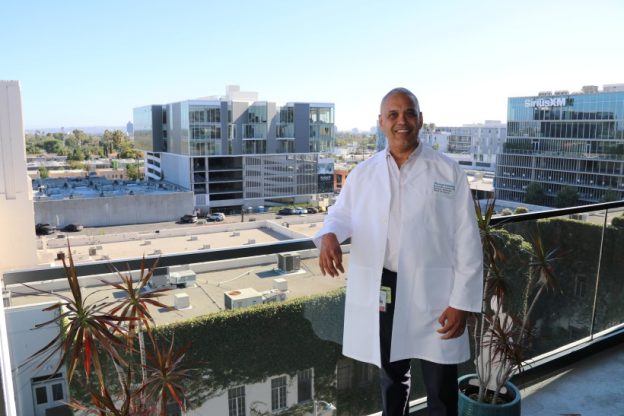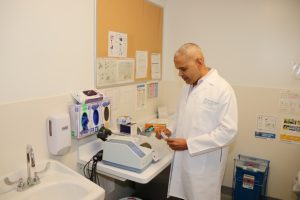
Physicians develop program to better control patient blood sugars
After COVID-19 hit in 2020, some physicians within Kaiser Permanente grew concerned that their patients with diabetes weren’t achieving healthy blood sugar control. Even when they came into the office for a visit, follow-up for getting labs to check on their hemoglobin A1c— a blood test that measures the average blood sugar level over the past 2 to 3 months—seemed to be lagging.
“It was the beginning of COVID,” recalled Reynaldo Alonso, MD, an internal medicine specialist with the Southern California Permanente Medical Group. “And because our patients with diabetes, especially those from underserved communities, weren’t coming in and following up as regularly, we were having a much harder time getting the diabetes control numbers we wanted.”
Uncontrolled diabetes has serious health risks
Diabetes is a chronic health condition that affects how the body turns food into energy and can result in too much sugar in the bloodstream. Over time, this can cause serious health problems and damage vital organs. However, studies have shown that effective blood sugar control can dramatically reduce the risk of eye disease, kidney disease, heart disease, and nerve disease in patients with diabetes.
Dr. Alonso, who has an office at Kaiser Permanente’s Hollywood Romaine Medical Offices in the heart of Hollywood, knew they could do better. However, the issue wasn’t just COVID. The time lag between doctor’s appointments and lab testing had been an issue for many patients with diabetes.
“We had for a long time seen that the lag time between the doctor’s appointment and lab testing could be an issue,” Dr. Alonso said. “If we could get the patient’s A1C test done in the office, we could address the need for more medication right there, or counsel the patient on the need for lifestyle changes that could help prevent diabetic complications.”
Putting A1C testing in the clinic
Other doctors in his clinic also had asked for a way to check A1C in the office, rather than sending patients to the lab. The Point-of-Contact A1C testing machine was about the size of a toaster and required only a drop of blood from a patient’s finger to run a test. The test took 2 to 3 minutes. But it was expensive, 10 times more expensive than having patients tested in the lab. And there was no standard procedure for how nurses or doctors would use it in the clinic.
At the time, Dr. Alonso was the assistant physician in charge and the diabetes champion for the office. He got an A1C testing machine and put it on the fifth floor of the Hollywood Romaine Offices. Primary care physicians were on both the fifth and sixth floors of the building.
“So, like any pilot at Kaiser Permanente, we bought just one machine and would see how it goes,” Dr. Alonso said. “At that time, I said this would be an ideal study, right? I proposed that we could compare the patients’ blood sugars on the fifth floor with the patients’ blood sugars on the sixth floor. It would be a perfect way to set up the study.”
Research could prove program’s worth
Dr. Alonso hadn’t published any research papers and the last time he even worked on a research project was when he was in medical school some 30 years earlier. But he knew that if he could show that having anA1C testing machine in the office improved blood sugar control, they could have a significant impact on patients’ diabetes.
Dr. Alonso got the study approved by the Kaiser Permanente’s Institutional Review Board, an independent committee that reviews proposed research involving human patients to ensure ethical conduct and protect patients’ rights. However, he was not only a practicing internist, but also chief of the department. His research time was limited. He also couldn’t find anyone to crunch the numbers to determine the outcomes.
Clinical workload made it difficult to pursue research
“Basically, I didn’t have the time or expertise to do the research,” Dr. Alonso recalled. “At first, I tried to find a researcher who had done diabetes work but was told that person had left. So that was that, and the research part was put on hold, despite the IRB approval.”
While the research stalled, the project moved forward.
“It took us about 6 months just to get all the kinks worked out on the fifth floor, logistical things like how the nurse was going to fit the testing into the routine appointment,” he said.
After about 6 months, they had a system and both patients and physicians were happy. They extended the project to the sixth floor.
Once the process on the sixth floor was going smoothly, Dr. Alonso shared the project with the primary care leadership at all Los Angeles Medical Center sites.
Leadership saw the potential of the program
Leadership was quickly on board and agreed to expand the program. John Martin, MD, the Diabetes Complete Care Condition Co-Leader, for Kaiser Permanente in Southern California, noted that while they were looking at the use of point-of-care testing for A1C for about 10 years, it hadn’t been proven as something that could be workable in the clinic setting.
“We had been looking for ways to utilize it in a way that would justify the added cost,” Dr. Martin said. “Our country spends over $400 billion in direct and indirect costs for the care of patients with diabetes. Given the complications that uncontrolled diabetes can have for our patients over the long term, we saw in this program the potential for this to pay for itself in better care, better outcomes, and fewer complications for our patients.”
Soon more than 7 clinics had the testing machines
Within 18 months, 3 clinics—with 2 to 3 machines each—were online. By 2022 it was expanded to all 7 primary care clinics at LAMC.
Dr. Alonso, who had become the chief of internal medicine and primary care lead for diabetes for the Los Angeles Medical Center, wanted to continue to expand the program.
But he still had no data. No way to tell the outside world with hard facts. No way to publish in a peer-reviewed journal that would show whether or not the project really worked.
One more attempt to quantify program’s success
In March 2024, he sent an email to Mingsum Lee, MD, PhD, Chief of Cardiology and Area Research Chair at the Los Angeles Medical Center.
“Can you help support us,” Dr. Lee remembers the email saying. “We thought, yes, you know what, this is an important question to study. We’re at a moment where technology can transform how we care for patients, but as we invest in technology, we must also make sure it truly drives better patient outcomes.”
Dr. Lee said she was excited to collaborate with Dr. Alonso on the research project.
Medical trainees became involved in the project
“At Los Angeles Medical Center, research is deeply embedded in the culture, with many faculty and graduate medical education trainees actively engaged in clinical studies,” Dr. Lee said. “The medical center’s leadership has established an infrastructure that offers support from data scientists and biostatisticians who partner with physicians in their research efforts.”
At the time, John Sim, MD, was leading medical education efforts at the Los Angeles Medical Center in his role as Director of Graduate Medical Education and Research. Internal medicine residents who work at the Hollywood Romaine office were taught and mentored by physicians including Dr. Alonso and Dr. Martin and participated in the implementation of the project, contributing to the data.
“The potential of this project was so exciting — we saw it as an example of how innovation and collaboration can help provide timely care, improve patient outcomes, and advance medical knowledge,” Dr. Sim said.
Reframing the question for research
However, making what might be seen as a great project on a relatively small scale into a research study that would be accepted into a recognized peer-reviewed journal isn’t easy.
To start, Dr. Lee helped set up the research in a different way. Instead of comparing one floor with the machine to another without, they matched patients who had received the test in the office with similar patients who did not, based on age and health conditions, and then compared the level of their diabetes control.
“I collaborated with (Dr. Alonso) to frame the question like a research study,” Dr. Lee said, “and designed a study to evaluate the hypothesis.”
If the numbers showed that the program reduced blood sugar levels, the research would support broader adoption of the program.
“If the research showed it wasn’t working well, then we might consider phasing it out,” she explained. “Research provides a thoughtful and systematic way to evaluate projects.”
They brought in an expert— SeungYoung Han, PhD, a biostatistician in the Department of Research & Evaluation—to pull the data and run the analysis. He, along with Dr. Lee, Dr. Alonso, and Dr. Martin authored the paper.
Patients with uncontrolled diabetes benefited the most
Their study looked at 10,909 diabetes patients with a primary care visit between Jan. 1, 2021, and Dec. 13, 2023. Of those, more than 3,000 patients had at least one visit where the A1C office test was used. The patients who had been tested in the office were matched with the same number of those who didn’t get the test.
The study showed that for patients with controlled diabetes, being tested in the office made little difference in their blood sugar levels. However, for patients with uncontrolled diabetes—defined as an A1c of 8% or greater—there was a significant reduction of 0.7% in A1c within 3 months.
“What this told us was that it may be best to target patients with a history of higher blood sugar levels than all people with diabetes,” Dr. Alonso said.
And despite the challenges there can be to publishing in a peer-reviewed journal, the study was solid. Dr. Lee submitted it to the Journal of General Internal Medicine, a prestigious peer-reviewed journal, in October. 2024. After minor revisions it was accepted in December of that year and published online in January 2025. It was published in print in August 2025.
“I wasn’t too surprised by the relatively quick acceptance,” Dr. Lee said, “as I knew the findings would be highly relevant to practicing internal medicine physicians.”
Published findings prompt wider expansion
Since the study findings became available in January, there has been a steady expansion of the program to new areas within Kaiser Permanente Southern California, such as San Diego, and new specialty clinics such as optometry, where a patient might seek care related to conditions resulting from their diabetes.
Dr. Martin noted: “By exploring the feasibility, costs, and impact on patient outcomes, the project addressed both the operational challenges and the potential to improve control over this prevalent chronic condition.”
Dr. Alonso said he believes the work will improve the future health of patients with diabetes.
“It’s been great to be able to work with patients and improve their life by hopefully preventing complications of diabetes,” Dr. Alonso said. “And it’s great to work in an organization like Kaiser Permanente where something like this – something so impactful – can be done.”





